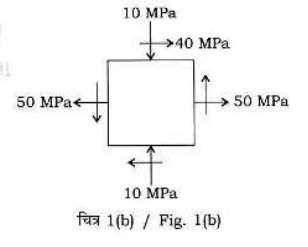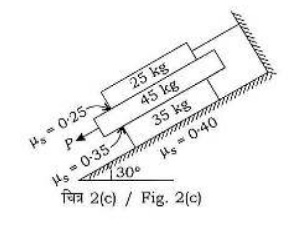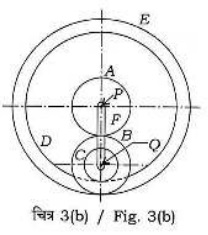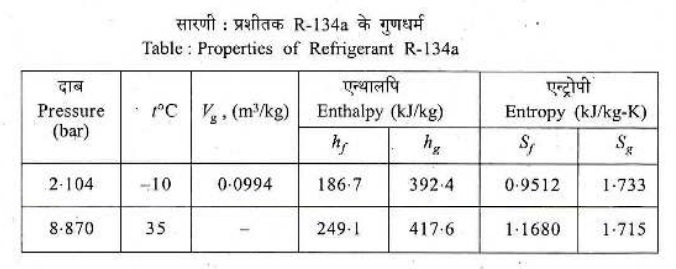NEW! The Gist (FREE) | E-BOOKS |
(Download) UPSC IAS Mains Exam Paper - 2017 : Mechanical Engineering

(Download) UPSC IAS Mains Exam Paper - 2017 : Mechanical Engineering
MECHANICAL ENGINEERING
(Paper - 1)
Time Allowed : Three Hours
Maximum Marks : 250
QUESTION PAPER SPECIFIC INSTRUCTIONS
Pleasc read each of the following instructions carefully before attempting questions.
There are EIGHT questions divided in two Sections and printed both in HINDI and in ENGLISH.
Candidate has to attempt FIVE questions in all.
Question Nos. 1 and 5 are compulsory and out of the remaining, THREE are to be attempted choosing at least ONE question from each Section.
The number of marks carried by a question/part is indicated against it.
Answers must be written in the medium authorized in the Admission Certificate which must be stated clearly on the cover of this Question-cum-Answer (QCA) Booklet in the space provided. No marks will be given for answers written in a medium other than the authorized one.
Wherever any assumptions are made for answering a question, they must be clearly indicated. Diagrams/figures, wherever required, shall be drawn in the space provided for answering the question itself.
Unless otherwise mentioned, symbols and notations have their usual standard meanings.
Attempts of questions shall be counted in sequential order. Unless struck off, attempt of a question shall be counted even if attempted partly. Any page or portion of the page left blank in the Question-cum-Answer Booklet must be clearly struck off.
SECTION-A
Q1. (a) A beam AB of length 2 m, hinged at A and supported at B by a cord which passes over two frictionless pulleys (P, Q), carries a 50 kN load as shown in Fig. 1(a). Determine the distance x, where 100 kN load is located on the beam, if the beam is to remain in equilibrium in horizontal position. Also determine the reaction at the hinged end.

(b) A state of plane stress is shown in Fig. 1(b).
Determine the following:
(i) Principal stresses
(ii) Principal planes
(iii) Maximum shear stress

(c) A thin spherical vessel of 1000 mm diameter and 2 mm thickness is subjected to an internal pressure of 4 MPa. The Young's modulus and Poisson's ratio are 200 GPa and 0-3 respectively. Find the following :
(i) Hoop stress fit
(ii) Change in volume of the vessel
(d) A steam engine develops 300 kW power at 9.5 rad/s. The coefficient of
fluctuation of energy is found to be 0.1 and fluctuation of speed is kept within
+0.5% of mean speed. Find the mass of the flywheel required if the radius of
gyration is 2m.
(e) A machine of mass 8 kg is supported on springs having combined stiffness of
5.4 N/m. A dashpot is attached to this stern that exerts a force of 40, when the
mass has a velocity of 1 m/s. Determine the following:
(i) Critical damping coefficient
(ii) Damping factor
(iii) Logarithmic decrement
(iv) Ratio of two consecutive amplitudes
Q2. (a) A simply supported beam of rectangular section is 200 mm wide and 300mm deep. It supports a uniformly distributed load of 6 KN/m Over an effective span of 4 m as shown in Fig. 2 (a). Calculate the magnitude and direction of the principal stresses at a point located at 0.50 m from the left support and 50 mm above the neutral axis.

(b) Compare the permissible diameter of a steel circular shaft, subjected to torsion, according to the following thcorics of failure. Assume Poisson's ratio to be 0.3 :
(i) Maximum stress theory
(ii) Maximum shear stress theory
(iii) Maximum strain thcory
(c) Fig. 2(c) shows three fat blocks positioned on the 30° incline. A force P parallel to the incline is applied to the middle block. The movement of the upper block is prevented by attaching to a fixed support by a wire. The coefficient of static friction for each of the three pairs of mating surfaces is shown in the figure. Determine the maximum value which P may have before any slipping takes place.

Q3. (a) A solid aluminum shaft 1 m long and 50 mm diameter is to be replaced
by a tubular steel shaft of the length and the same outside diameter (i.e., 50
mm) such that each of the two shafts could have the same angle of twist per unit
tensional moment over the total length. What must the inner diameter of the
tubular steel shaft be? The modulus of rigidity of steel is three times that of
aluminum.
(b) A compound epicycle gear is shown in Fig. 3(b). friar A, Dared I are free to
rotate on axis P. Compound gears B and Rotate together on axis Q at the end of
arm P. All the gears have equal pitch. The number of external teeth on cars A, B
and Gars 18, 45 and 21 respectively. Gears D and are annular gears. Gear A
rotates at 100 r.p.m. in counter-clockwise direction and gear D rotates at 450
r.p.m, clockwise. Find the speed and direction of arm F and gear E.

(c) For a eutectoid steel, draw and label continuous cooling transformation (CCT) diagram. Explain normalizing and hardening heat treatment with regard to phase transformation using relevant cooling curves on CCT diagram.
Q4. (a) Four masses A, B, C and D are attached to a shaft and revolve in the
same plane. The tresses are 13 kg, 10 kg, 18 kg and 15 kg respectively and their
radii pouf rotator are 40mm, 50mm, 60mm and 30mm respectively. The angular
position of mass B, C and D arc60o 135o 270o
from the mass A. Find the magnitude and position of balancing mass at a radius
of 100mm.
(b) Draw the stress-strain diagram for mild steel and describe the salient
points of the curve.
(c) A Porter governor having all arms of 240 mm length is pivoted on the axis of
rotation. Each ball has a mass of 5 kg and the load on the sleeve is 18 kg. The
ball path is 150 mm when the sleeve begins to rise and 200 mm at the maximum
speed. Find the following:
(i) Range of speed
(ii) Coefficient of sensitiveness, if the friction at the sleeve is equivalent
to a forces of 10 N.
SECTION-B
Q5. (a) Electrochemical machining of 400 mm2 surface of iron is
performed using supply voltage of 15 V and tool-workpiece gap of 0.3 mm.
Considering gap resistance for the flow of current through electrolyte to be
0.0015W ,calculate the frietal removal rate, MRR (m3/s).
The relevant data for iron are the following:
Valency = 2
Atomic weight = 55.85
Density = 7860 kg/m3
Faraday's constant = 96540 coulombs
(b) An annealed copper plate of 300 mm width and 20 mm thickness is rolled to
16 mm thickness in one pass. Considering radius of the roller as 400 mm,
rotational speed of 80 r.p.m. and average flow stress during rolling as 400 MP3,
calculate the true strairi and rolling force (kN).
(c) The machining of steel is carried out using two types of cutting tool, i.e.,
tool A and tool B. Data/technical parameters related with tools are given below
in the table, which tool will you prefer for 200 minutes of tool life and why?

(d) Describe the philosophy of lean management including waste and value
stream with regard to manufacturing.
(e) The demand for an item is 500 units and 600 units for July and August
respectively. Considering forecast for July as 300 units, determine the forecast
for September using exponential smoothing method. Assume value of a as 0.3.
Q6. (a) For orthogonal turning using a cutting tool having a rake angle of 5o, the following data is given :
Chip-thickness ratio = 0.5
Rake angle = 5o
Main cutting force = 1600 N
Thrust force = 1300 N
Calculate the shear planc angle, friction force (N), normal force (N) and coefficient of friction at chip-tool interface.
(b) Two aluminum plates are welded using tungsten inert gas (TIG) welding
process with the help of welding current 150 A, arc voltage 12 V and arc travel
speed 2 mm/s. Considering heat transfer efficiency of TIG welding process as 90%
and heat required for melting unit column of metal (AI) as 15J/mm3,
calculate the melting efficiency of the process if the cross-sectional area of
the weld joint is 20mm2
(c) Explain the principle of abrasive waterjet machining using suitable
schematic. Write the advantages and applications of abrasive waterjet machining.
Q7. (a) The following limits are specified to give a clearance fit between a shaft and a hole in a limit system :

Calculate the following:
(i) Basic size
(ii) Shaft and hole tolerances
(iii) Shaft and hole limits
(iv) Maximum and minimum clearances
(b) Lathe machine operations take 40 min to produce a product. If the
efficiency of the lathe machine is 80% and rejection is 20%, then determine the
number of lathe machines required for producing 800 pieces per week. Assume 52
weeks per year and 48 hours per week as working hours available.
(c) A manufacturing company is producing an item for which the following
information is given :
Selling price per unit = 20
Variable cost per unit = 10
Fixed cost = 2,00,000
However due to changing market condition, variable cost incrcased by 20% and fixed cost increased by 10%. If the breakdown quantity is maintained, then what will be the revised selling price?
Q8. (a) Monthly consumption of an item is 350 units and price per unit is 15. Inventory carrying cost is 20 percent and ordering cost is 40 per order; lead time pf 1 month stock. Assuming ROL system, calculate the following:
(i) Reorder quantity
(ii) Reordering level
(iii) Minimum level
(iv) Maximum level
(v) Average inventory
(b) A car manufacturer performs final inspection before shipping to the dealers. The final inspection involves testing and inspection of car with regard to number of parameters. There is a possibility that a car may fail to satisfy various parameters (which can be termed as defects). Periodically ten (10) cars were taken randomly for testing and inspection. Data obtained after inspection and testing of each car with regard to number of defects is given below. Determine the control limits for C chart and comment :

(c) Describe different types of control systems possible for CNC operations along with respective applications using suitable schematic.
DOWNLOAD 10 YEARS UPSC MAINS MECHANICAL ENGINEERING PAPERS PDF
DOWNLOAD UPSC MAINS G.S. (1-4) SOLVED PAPERS PDF
DOWNLOAD UPSC MAINS G.S. 10 Year PAPERS PDF
DOWNLOAD UPSC IAS EXAMS E-BOOKS PDF
UPSC Mains General Studies Study Kit
MECHANICAL ENGINEERING
(Paper - 2)
Time Allowed : Three Hours
Maximum Marks : 250
QUESTION PAPER SPECIFIC INSTRUCTIONS
Pleasc read each of the following instructions carefully before attempting questions.
There are EIGHT questions divided in two Sections and printed both in HINDI and in ENGLISH.
Candidate has to attempt FIVE questions in all.
Question Nos. 1 and 5 are compulsory and out of the remaining, THREE are to be attempted choosing at least ONE question from each Section.
The number of marks carried by a question/part is indicated against it.
Answers must be written in the medium authorized in the Admission Certificate which must be stated clearly on the cover of this Question-cum-Answer (QCA) Booklet in the space provided. No marks will be given for answers written in a medium other than the authorized one.
Wherever any assumptions are made for answering a question, they must be clearly indicated. Diagrams/figures, wherever required, shall be drawn in the space provided for answering the question itself.
Unless otherwise mentioned, symbols and notations have their usual standard meanings.
Attempts of questions shall be counted in sequential order. Unless struck off, attempt of a question shall be counted even if attempted partly. Any page or portion of the page left blank in the Question-cum-Answer Booklet must be clearly struck off.
SECTION-A
Q1. (a) An insulated rigid tank is divided into two cqual parts by a
partition. Initially, one part contains 4 kg of an ideal gas ar 800 Kpa and 50oC.
While The other part is evacuated. The partition is now removed and the gas
expands into the entire tank. Determine the final temperature and pressure in
the tank.
(b) Show processes of saturated vapour compression refrigeration cycle on p-v,
t-s and p-h diagram and mark graphically on t-s diagram refrigerating effect,
heat rejection by condenser and compressor work.
(c) What is the shape factor in case of radiative heat exchange ? Discuss the
four (4) basic shape factor laws.
(d) Draw valve timing diagrams of 4-stroke high speed and low speed SI internal
combustion engine.
(e) Define steam, quality and derive expression for specific volume of steam in
terms of steam quality. v = vf + xvfg
Q2. (a) The efficiencies of the compressor and turbine of a gas
turbine are 70% and 71%, respectively. The heat added in the combustion chamber
per kg of air is 476.35 kJ/kg. Find a suitable pressure ratio such that the work
ratio is 0.054. Also find the corresponding temperature ratio. The inlet total
temperature of air is 300 K.
(b) A flue gas stream is to be monitored for its temperature using a
thermocouple. The thermocouple design needs to be evaluated in terms of its time
response to accurately predict the measured temperature. The thermocouple
junction can be approximated as a sphere of diameter 0.6 mm, density of the bead
material (p) 8500 kg/m3, thermal conductivity (k) is 310 W/rn-K; specific heat
(c) is 0.3 kJ/kg-K. The convective heat transfer coefficient (h) between the
junction and flue gas is 300 W/m-K, Determine the time required to read 90% of
the initial temperature difference. Neglect radiation effect and change in
thermo physical Properties with temperature.
(c) Classify different types of boilers and discuss factors important for the
boiler selection.
Q3. (a) In an open heart surgery, under hypothermic conditions, the
patient's blood is cooled before surgery and rewarded afterwards. It is proposed
that a concentric tube counter flow heat exchanger of length 0.5 m is to used
for this purpose, with a thin walled inner tube having diameter of 55 min. If
water at 60°C and 0.1 kg's is used to heat the blood entering the heat exchanger
at 18°C at a flow rate of 0-01 kg/s, what is the temperature of the blood
leaving the heat exchanger ? one may assume, overall heat transfer coefficient
(LU) = 500 W/rfm-k, specific that of blood and water are respectively Cpblood
3.5 kJ/kg-K, Cpwater = 4.187 kJ/kg-K.
(b) A single cylinder 4 stroke SI engine is producing 100 KW power at an overall
efficiency of 20% Engines use a fuel-air ratio of 0.07 : 1. Determine how many m3/hr
of air is used if air density is 1.2 kg/m). The fuel vapour density is 4 times
that of air. How many m/hr of mixture is required ? Calorific value of fuel is
42000 kJ/Kg.
(c) The pressure in an automobile tyre depends on the temperature of the air in
the tyre. When the air temperature is 25°C, the pressure gauge reads 210 kPa. If
the volume of the tyre is 0.025 m, determine the pressure rise in the tyre when
the air temperature in the tyre rises to 50°C. Also, determine the amount of air
that must be bled off to restore pressure to its original value at this
temperature. Assume the atmospheric pressure is 100 kPa and gas constant of air,
R = 0.237 kpa m3/kg-K.
Q4. (a) A six cylinder 4-stroke diesel engine has a bore of 60 mm and a crank radius of 32 mm. The compression ratio is 9 : 1 and engine volumetric efficiency is 90%, Determine :
(i) Stroke length
(ii) Mean Piston seed at 1000 rpm
(iii) Swept volume per cylinder
(iv) Clearance volume per cylinder
(v) Cubic capacity of the engine
(vi) Actual volume of air aspirated per stroke in cach cylinder
(b) The rotor of an axial flow fan has a mean diameter of 30 cm. It runs at
1470rpm. Its velocity triangles at entry and exit are described by the following
data :
Peripheral velocity components of the absolute velocities at entry and exit are
:
Cy1 = 1/3u, Cy2 = 2/3u where, C = fluid velocity, u = peripheral speed
(i) Draw the inlet and exit velocity triangles for the rotor and prove that
the work is given by = wc = 1/3u2.
(ii) Calculate the pressure rise, take a constant density of air, P= 1.25 kg/m.
(c) Explain clearly what is thermally developed zone" in case laminar flow through a tube both for (i) constant all temperature case (ii) constant heat flux case.
SECTION - B
Q5. (a) What is the difference between 'normal' and 'oblique' shock ?
State the significance of each.
(b) Explain harmful effects of R-12 and R-22 refrigerant. Write their chemical
formula and NBP temperature. Also suggest new eco-friendly substitutes of these
two with chemical composition.
(c) Discuss experimental determination of calorific value of solid fuel with a
neat diagram.
(d) The air-fuel ratio of an SI engine varies from 110-load to full load
condition. Write air-fuel ratio requirement for an engine under following
conditions with reason :
(i) Idling condition
(ii) Cruising condition
(iii) High load condition
(iv) Cold-start condition
(e) A sample of fuel was found to have the following percentage analysis by
weight :
C 80; H2 16; and ash etc. 4. Determine the minimum weight and volume
of air required to burn 1 kg of this fuel. Density of O2 is 1.429
Kg/m3?
Q6. (a) A single stage, single acting vapour compression refrigeration system uses R-134a. Condenser and evaporator temperatures are 35°C and -10°C and refrigerant is under-cooled by 5°C. Clearance volume per swept volume is 0.03 and swept volume is 269.4 cm. Compressor speed and efficiency are 2800 rpm and 80% respectively. Expansion index is 1.12. Determine (1) Compressor exit temperature (ii) Enthalpy of refrigerant at compressor exit (iii) Enthalpy at the exit of the sub-cooler (iv) Volumetric efficiency of compressor (v) Refrigerant mass flow rate. Specific heat of vapour and liquid at condenser pressure are 1.1 kJ/kg-K and 1-458 kJ/kg-K respectively. Assume suction vapour dry saturated and isentropic compression.

(b) (i) Explain about (I) back pressure turbine (II) by-product power cycle
(III) co-generation plant (IV) tri-generation plant,
(ii) Define overall efficiency, boiler efficiency, cycle efficiency, mechanical
efficiency and generator efficiency of a Rankine cycle based power plant and
also prove that:
(c) A supersonic wind tunnel settling chamber expands air through a nozzle from a pressure of 10 bar to 4 bar in the test section. Calculate the stagnation temperature to be maintained in the settling chamber to obtain a velocity of 500 m's in the test sectio11. Take C = 1.025 kJ/kg-k and Cur = 0.735 kg/kg-K.
Q7. (a) The mean diameter of the blades of an impulse turbine with a single row wheel is 105 cm and the speed is 3000 rpm. The nozzle Angle is 18o, the ratio of blade speed to steam speed is 0.42 and the ratio of the relative velocity at outlet from the blades to that at in lot is 0-84. The outlet angle of the blade is to be made 3° less than the inlet angle. The steam flow is 8 kg per sec. Draw the velocity diagram for the blades and estimate the (i) resultant thrust on the blades (ii) tangential thrust on the blades (iii) axial-thrust on the blades (iv) power developed in blades and (1) blade Efficiency
(b) A small disc-shaped earth satellite, 1 m in diameter circles the earth (radius (625) km) at a distance of 300 km from the surface. The flat surface of the disc is oriented tangential to the earth's surface. The satellite surface has an emissive of 0.3 and is at -18°C. Calculate the net rate at which energy is leaving the satellite. Assume that :

(i) The average earth surface temperature is 27°C and the Earth is black
body.
(ii) The satellite is in shadow of the earth and
(iii) The part of the satellite surrounding not occupied by the earth is black
and at O K.
(iv) Stefan-Boltzimann constant = 5.67 x 10-8 W/m2-K4.
(c) Differentiate clearly between ventilation and infiltration. Discuss the methods of cstimation of infiltrated air.
Q8.(a) The engine test on a single cylinder four stroke diesel engine has following observations :
Test duration = 1 hr
Bore x Stroke = 0.3 m x 0.45 m
Fuel consumption = 11.4 kg
Calorific Value of fuel = 42 MJ/kg
Indicated mean effective pressure = 6 bar
Net load on brake = 1500 N
Engine rpm = 300 rpm
Brake drum diameter = 1.8 m
Brake rope diameter = 20 mm
Quantity of the jacket cooling water = 600 kg
Temperature rise of cooling water = 55°C
Quantity of exhaust measured = 290 kg
Exhaust gas temperature = 420°C
Specific heat of exhaust gas = 1.03 kJ/kg-K
Ambient temperature = 20oC
Estimate :
(i) The indicated power
(ii) The brake power
(iii) The indicated thermal efficiency
(iv) Draw up an energy balance sheet
(b) In an air-conditioning plant, an air handling unit supplies a total of
4000 m/min of dry air which comprises by mass 20% of fresh air at 39°C DBT and
26°C WIT and 80% re-Circulated air at 24°C DBT and 50 RII. The air leav19 the
Cooling coil at 12°C saturated: Using Psychometric chart calculate (i) Total
cooling load and (ii) Room heat gain. Also slicow the process on Psychometric
chart.
(c) Write down the assumptions to analyze a counter flow heat exchanger using
LMTD (Log mean temperature difference) method and also write down the expression
for LMTD in a counter flow heat exchanger with the help of terminal
temperatures.


